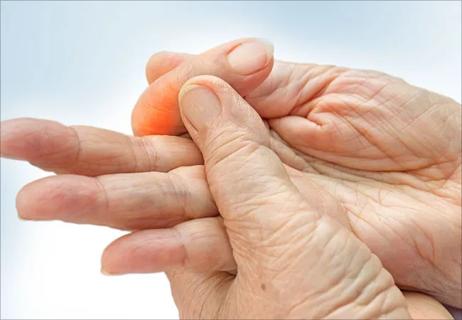Frequent smartphone use can lead to painful issues

Cellphones have changed our lives, but are they also causing injuries? The internet seems to think so. Smartphone pinky is just one of many device-related injuries that have gone viral in recent years.
Advertisement
Cleveland Clinic is a non-profit academic medical center. Advertising on our site helps support our mission. We do not endorse non-Cleveland Clinic products or services. Policy
Orthopaedic surgeon Peter J. Evans, MD, PhD, says, “Constant cellphone use can cause a range of joint problems. While some claims of injury might be overstated, others are real and involve serious, long-term damage.”
Spending hours a day on your phone places an unnatural strain on your joints. The most common smartphone-related injuries include:
Online images of smartphone pinky show a wide gap between your ring and pinky fingers. Other photos point to a bump in your pinky where you support your phone when you’re talking, texting or scrolling.
“But most of these images don’t highlight a problem. They show typical pinky anatomy, which can vary widely,” says Dr. Evans. “It’s also possible that people who think they have smartphone pinky could have an underlying condition.”
He suggests the cause could be one of the following:
Advertisement
According to Dr. Evans, there’s a slight risk that supporting your phone with your pinky could compress a nerve in your finger. Over time, you could experience pain, numbness or tingling.
“But tingling or numbness in your pinky could also signal a more serious condition called cubital tunnel syndrome. This condition is also known as smartphone elbow,” says Dr. Evans.
Cubital tunnel syndrome is a cumulative traction/compression injury to your ulnar nerve, one of the main nerves in your arm, that occurs when you bend your elbow too frequently beyond 90 degrees.
Holding your phone up when talking or texting can cause or aggravate existing cubital tunnel syndrome — hence the name “smartphone elbow.” But sitting in a low chair and over-flexing your elbow or resting it on the arms of your chair when you’re typing, or sleeping with your arms tucked in, is equally bad, notes Dr. Evans.
Your ulnar nerve travels down your inner arm and then around the bony prominence (epicondyle) of your elbow before it reaches your ring and pinky fingers. It provides sensation and controls movement. At your elbow, your ulnar nerve passes through a narrow opening at the epicondyle called the cubital tunnel.
Bending your elbow causes traction and places pressure on your ulnar nerve at the cubital tunnel. Repeated elbow bending can cause long-term nerve damage.
Smartphone elbow symptoms include:
Talk to your healthcare provider if you have tingling or numbness in your pinky when you bend your elbow or when you sleep. Dr. Evans cautions that if your symptoms don’t go away when you straighten your arms, it might be more severe, and you could experience permanent loss of function.
“Early stages of nerve damage are reversible,” he says. “With a minimally invasive surgery, we can open the cubital tunnel. The nerve heals completely. But if scar tissue builds up, the nerve continues to deteriorate and that can be permanent. However, surgery is still important to prevent further progress, even more sensory and motor loss and subsequent deformity.”
Texting thumb is a repetitive motion injury. “Your thumb joints aren’t made to text and swipe all day long,” states Dr. Evans. “Overuse can aggravate underlying conditions, like arthritis, or cause new problems in the thumb tendons.”
Tendons are strong bands of tissue that connect muscles to bones. Several tendons travel from your forearm across your wrist to your thumb. At the base of your thumb, the tendons pass through a narrow tunnel that helps keep them in place.
Advertisement
Rapid, repetitive thumb movements can cause inflammation in the synovium, the tissue around the tendons. This condition is called tenosynovitis and can be very painful.
Texting thumb isn’t new. Many types of activities can lead to tenosynovitis in your thumb joint. The Swiss surgeon Fritz de Quervain recognized thumb tenosynovitis in 1895. It later became known as de Quervain’s syndrome. Other names for it include:
Trigger thumb is another type of tenosynovitis that can occur with frequent texting. It occurs when your tendon doesn’t glide smoothly inside its narrow tunnel on the palm side of your thumb. You may feel a clicking or popping. Eventually, your thumb may get stuck.
Text neck is another repetitive strain injury caused by hunching over your smartphone. “Your head weighs around 10 to 12 pounds,” notes Dr. Evans. “When you look down, you increase the load on your neck muscles. This added pressure can cause muscle pain and spasms.”
“Tingling, pain and clicking in a joint are signs that you should take a break from your device,” explains Dr. Evans. “Ibuprofen or other nonsteroidal anti-inflammatory drugs can also help.”
Advertisement
Dr. Evans also recommends switching your posture frequently. For example, try to:
If your symptoms don’t go away or get worse, talk to a healthcare provider. Early diagnosis and treatment can help you reduce pain and prevent lasting damage to your joints.
Advertisement
Learn more about our editorial process.
Advertisement

The Short Answer from a rheumatologist

A compressed ulnar nerve at the elbow can cause symptoms in your hand

Most recommended precautions center around minimizing bruising or swelling

Even one drink can have an impact on your cognitive function leading to slurred speech, blurred vision and impaired memory

Understand who may (and may not) benefit

Lorem ipsum dolor sit amet. Et odio Quis vel ipsam omnis eum alias deleniti et placeat impedit non voluptas galisum hic autem enim et cupiditate aliquid. Est beatae quidem non facilis autem ut commodi nisi aut tempore rerum et dolores voluptatem cum enim optio id sapiente quasi. Ad laboriosam officiis 33 cupiditate sequi ea voluptatum consectetur qui necessitatibus voluptate et quasi doloremque et facere explicabo quo explicabo officia

Type 2 diabetes isn’t inevitable with these dietary changes

Applying a hot or cold compress can help with pain